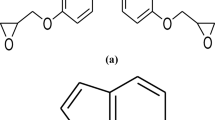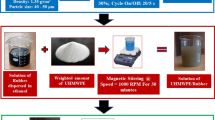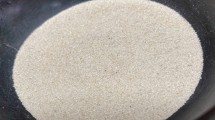Abstract
There is an increased demand for abrasive wear-resistant coatings that add durability to steel hydraulic structures, particularly for those subjected to flowing water with debris and alternate wet/dry cycles. These coating systems provide not only corrosion and chemical resistance, but also good erosion and abrasion resistance to the metallic surfaces, which are constantly exposed to flowing water containing sand particles and debris. Generally, vinyl-based coatings are used on hydraulic steel structures to protect them from corrosion and abrasion. However, due to the existence of high water force and debris, the coating is abraded at a faster rate leading to significant maintenance and repair costs. In this study, abrasive wear resistance of conventional vinyl-based coating systems currently used on lock and dam steel structures by U.S. Army Corps of Engineers has been compared with polymer matrix composite coatings, fibrous polymer coatings, and ultrahigh molecular weight polyethylene (UHMWPE). Six coating systems were evaluated through two-body abrasion tests using a reciprocating abrader under dry and wet conditions. Furthermore, wettability of the coating systems and its effect on the wear rate under the presence of water was studied. In addition, scanning electron microscopy of the wear tracks on different coatings was conducted to study and identify their failure mechanisms. Based on the results, UHMWPE and polymer–ceramic composite coatings were found to perform significantly better than the conventional vinyl-based coatings.











Similar content being viewed by others
References
Grier, DV, “The Declining Reliability of the US Inland Waterway System.” Institute for Water Resources (2009)
Beitelman, AD, Finney, DL, “Inspection of Coating Systems on Civil Works Structures: Lessons Learned.” DTIC Document (1989)
Vijay, P, Soti, PR, GangaRao, HV, Lampo, RG, Clarkson, JD, “Design and Evaluation of an Integrated FRP Composite Wicket Gate.” Compos. Struct., 145 149–161 (2016)
Lampo, R, Wiggins, CE, “Abrasion-Resistant Polymer Composite Overlays and Coatings. Technologies to Extend the Life of Existing Infrastructure.” US Army Corps of Engineers (2015)
Race, TD, Hock, VF, Beitelmen, A, “Evaluation of Abrasion-Resistant Metallized Coatings for Civil Works Applications.” DTIC Document (1990)
Jackson, J, “Cost of Corrosion Annually in the US Over $1 Trillion.” G2MT Labs LLC, Houston, TX (2014)
Koch, GH, Brongers, MP, Thompson, NG, Virmani YP, Payer, JH, “Corrosion Cost and Preventive Strategies in the United States.” Federal Highway Administration (2002)
McInerney, MK, Marsh, CP, Hock, VF, Carlson, TA, “A Survey of Corrosion and Conditions of Corrosion Protection Systems in Civil Works Structures of the US Army Corps of Engineers.” DTIC Document (2014)
Barrow, D, Petroff, T, Sayer, M, “Thick Ceramic Coatings Using a Sol Gel Based Ceramic-Ceramic 0–3 Composite.” Surf. Coat. Technol., 76 113–118 (1995)
Leyland, A, Matthews, A, “Design Criteria for Wear-Resistant Nanostructured and Glassy-Metal Coatings.” Surf. Coat. Technol., 177 317–324 (2004)
Kumar, P, Oka, M, Ikeuchi, K, Shimizu, K, Yamamuro, T, Okumura, H, “Low Wear Rate of UHMWPE against Zirconia Ceramic (Y-PSZ) in Comparison to Alumina Ceramic and SUS 316L Alloy.” J. Biomed. Mater. Res., 25 813–828 (1991)
McKellop, H, Clarke, I, Markolf, K, Amstutz, H, “Wear Characteristics of UHMW Polyethylene: A Method for Accurately Measuring Extremely Low Wear Rates.” J. Biomed. Mater. Res., 12 895–927 (1978)
Muratoglu, OK, Bragdon, CR, O’Connor, DO, Jasty, M, Harris, WH, Gul, R, “Unified Wear Model for Highly Crosslinked Ultra-high Molecular Weight Polyethylenes (UHMWPE).” Biomaterials, 20 1463–1470 (1999)
USACE. United Facility Guide Specification (UFGS) Division 09 – Finishes, Section 09 97 02–Painting: Hydraulic Structures, UFGS-09 97 02., 2009
G133-05, “A Standard Test Method for Linearly Reciprocating Ball-on-flat Sliding Wear.” ASTM International (2010)
Rutherford, K, Hutchings, I, “A Micro-abrasive Wear Test, with Particular Application to Coated Systems.” Surf. Coat. Technol., 79 231–239 (1996)
Fildes, J, Kilparti, R, Meyers, S, Schelp, E, “Quantifying Abrasive and Adhesive Wear of Coatings with a Ball on Three Disk Configuration.” US Army Joint Munitions & Lethality LCMC ACQ Center, Institute of Tribology and Coatings (2010)
Chaudhury, MK, “Interfacial Interaction between Low-Energy Surfaces.” Mater. Sci. Eng., 16 97–159 (1996)
Paranusorn, P, Fernandez, BL, Supavasuthi, C, Somwangthanaroj, A, “Effects of Additives in Ethylene Glycol-based Lubricant on Selective Material Removal in Slider Lapping Process.” Procedia Chem., 19 166–173 (2016)
Pawlak, Z, Urbaniak, W, Oloyede, A, “The Relationship between Friction and Wettability in Aqueous Environment.” Wear, 271 1745–1749 (2011)
Borruto, A, Crivellone, G, Marani, F, “Influence of Surface Wettability on Friction and Wear Tests.” Wear, 222 57–65 (1998)
Vijay, PV, GangaRao, HVS, Soti, PR, “Evaluation of Composite Coating Systems for Hydraulic Gates.” US Army Corps of Engineers Report: WVU-CFC (2014)
Acknowledgments
The authors gratefully acknowledge the financial support from the U.S. Army Corps of Engineers and Benjamin M. Statler College of Engineering, West Virginia University, Morgantown, WV. Support from the Constructed Facilities Center, West Virginia University, and all the engineering and supporting staff at the USACE and Howell Heflin Lock and Dam is sincerely acknowledged. Laboratory samples and field help from Prof. Gangarao of CFC and Mr. Jeff Ryan of USACE are sincerely acknowledged. In addition, authors would like to thank A. W. Chesterton Company for providing polymer–ceramic coatings.
Author information
Authors and Affiliations
Corresponding author
Additional information
Publisher's Note
Springer Nature remains neutral with regard to jurisdictional claims in published maps and institutional affiliations.
Rights and permissions
About this article
Cite this article
Vijay, P.V., Soti, P.R., Banerjee, D.A. et al. Abrasion resistance of polymer and polymer–ceramic composite coatings for steel hydraulic structures. J Coat Technol Res 17, 401–411 (2020). https://doi.org/10.1007/s11998-019-00286-3
Published:
Issue Date:
DOI: https://doi.org/10.1007/s11998-019-00286-3




